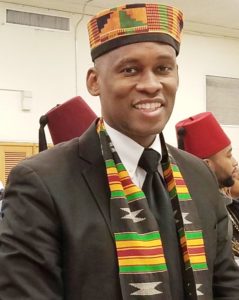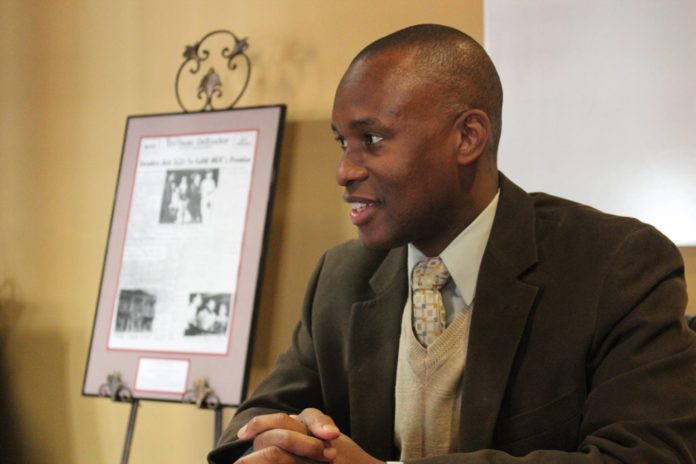Attorney Van Turner Jr. made his way to a seat reserved for him at the front of the room at the Panhellenic Building on the campus of the University of Memphis, where Mid-South Kwanzaa, Inc. was celebrating the principle of Imani (faith) on the last day of Kwanzaa.
Widely known as a member of the Shelby County Board of Commissioners, Turner’s arrival aroused a stir, but not for being an elected official. The speaker addressing the crowd paused amid her remarks, taking note of Turner calling him “my hero.”
Turner is the head of Memphis Greenspace, Inc., the suddenly high-profile nonprofit group that bought two city parks and promptly removed the statues saluting Confederate-era figures. Most notable was the monument to controversial Confederate Gen. Nathan Bedford Forrest.
On Tuesday, Turner visited The New Tri-State Defender, having a wide-ranging conversation with Associate Publisher/Executive Editor Karanja A. Ajanaku. That conversation begins here and will be continued online at TSDMemphis.com.
Giving his name for the record, Turner noted that “my African name” given to him while attending Morehouse College in Atlanta is Njojo, which means discipline.

Karanja A. Ajanaku: Discipline? Wow, you’ve had to use that in the last few days haven’t you:
Van Turner Jr. Yes, I’ve had to.
Turner acknowledged that the sentiment expressed by the speaker who interrupted her talk at Kwanzaa mirrored other expressions he has heard recently. Much of it is from persons who have had to live with the presence of the statues.
VTJ: (At the) press conference (the day after the statue’s removal) I talked about my father and how … he grew up the majority of his youth in LeMoyne-Owen Gardens. And then the family moved to Binghampton and at one point in time he was very close to where the park was. … He recalled as a young man not been able to really walk through the park without being accompanied by a white or being able to sit down at the park. That really left a very bad impression on him and countless other black youth in the community. So you really hear from them. They are very happy that the statue has been removed.
KAA: Is your dad still alive?
VTJ: He’s still alive. He’s 74. We actually moved the statue on his birthday. …
KAA: One of the questions is, where are the statues? What are you going to do with them?
VTJ: I just got a call this morning … (indicating) that we had moved the statues to Florida.
There’s all kind of rumors out there. We have to really kind of keep that undisclosed because we want to protect the persons who are housing the statues. For the immediate time, they were housed at the Memphis Police Department. They were going to present an invoice to us, which we will pay. And then they will be moved there to an undisclosed location to protect the assets as well as the persons who are housing the assets.
We had two companies that stepped up and they pulled back because of all of the controversy. They didn’t want anything to happen to their business. …understanding that one of the companies involved in (removal of the) New Orleans statues had their company … firebombed. …
At the appropriate time we’ll say what’s going on… Part of the deal we had to sign with the people who are housing it is that we can’t say they are housing it.
KAA: Is reasonable to think that you would work with the members of the Forrest family or any other family members connected to the statues.
VTJ: Yes sir, most definitely. The (state) AG’s (attorney general’s) office has reached out to us. Of course our friends and legislators in the General Assembly, some are not pleased. …The attorney general has reached out through their local representative … who is a former chancellor. I’ve written him a letter and I’ve touched bases with the governor to say that the assets would be secure, protected and we will transfer those assets in good form to persons interested and we want to get priority treatment to the family. …
Turner said he also had talked to a family member of war correspondent and Capt. J. Harvey Mathes, whose bust was removed from Memphis Park, along with the statue of Jefferson Davis, the president of the Confederate States of America.
VTJ: Basically what I’ve indicated to him is that we are going to get the blessing of the AG’s office. And at that point in time we’ll transfer the…bust. We’ll also, hopefully, be able to work out a deal with the Forrest family, along with the graves. As we all know, the graves were moved from Elmwood (Cemetery) to the current location. So, if we’re going to be historically accurate, the graves should be back at Elmwood. … And with the Davis statue, I’m sure there are a number of Confederate memorial museums or parks, which would be interested in receiving the statue of Jefferson Davis…. We’re open to that as well you say.
KAA: You say, “we.” Obviously we’re talking about Memphis Greenspace. What can you tell us about … how Memphis Greenspace came into being?
VTJ: I filed with the Secretary of State, I believe, on October 5 or thereabout. … The board members are Luther Mercer, Janique Byrd, Andrew DeShazo and Leigh Chiles… Prior to that time I had reached out to them, or their names were given to me by folks who are concerned about this in the city. I talked with them and asked if they were interested. Understanding that there would be some publicity – some positive, some negative. Would they be in a position to undergo all of that? With their employers and all of that. Once all of that was established and everybody was OK, we went forward and formed a non-profit .
Marty Regan, who is a well-known attorney, who deals a lot with nonprofits, (is) our lawyer and he helped form the company. …
We have to file an exemption with the assessor’s office. We want the property still to be tax exempt like it was with the city. … Speaking of the assets, the bust of Mathes and the statues of Forrest and Davis, we’re transferring those and it’s not for profit. … I’ve heard different things … that this is a money grab. That’s not the case. We’re non-profit and that’s how we’re going to carry out our business. We will not be in the business of selling those assets/statues for profit.
KAA: I’ve read where Mayor (Jim) Strickland has said he noticed some time ago that there was a loophole that could be brought into play (for removal of the statues). What is the relationship between his recognition of that loophole and the birth of Memphis Greenspace?
VTJ: Obviously it’s closely aligned. That loophole was recognized but it still is a step in order to take advantage of loopholes. And that was there had to be an ordinance passed to allow the city to transfer property for a nominal amount of money, which was not the case at first. That ordinance was passed first and that sort of cleared the way to allow the transfer. This wasn’t just an immediate thing that just happened overnight.
I think that when the mayor recognized it, there was a gap there. How do you get the property into private hands in order to do it? And there needed to be that ordinance that was passed, which allowed it to occur. I think once the mayor sort of oversaw that, once that was done, that really cleared the way to allow the transfer to happen.
I’d be the first to say that I appreciate the mayor for stepping up to do what he’s done.
KAA: Did he approach you about Memphis Greenspace?
VTJ: I never really talked to the mayor a lot. I’ve really dealt most with Bruce McMullen, the city attorney. … Part of what the opposition wants to say is that we are a sham organization; that the city is going through us.
KAA: But they came to you with idea? Is that true?
VTJ: No. I know Bruce personally. Before Bruce was the city attorney, my law firm was doing business with the city. …Actually some of this was started when Myron Lowery was the pro tem mayor; some of the thought processes. Even before that, …I think I saw an article where (Commissioner) Walter Bailey had approached (Memphis) Mayor (W.W.) Herenton to see if something could be done. I think everybody had kind of been thinking along these lines.
We (the county commission) passed a resolution over the summer supporting the city council’s initiative to remove the statues. At that particular time, just in my looking at what was going on and doing the little research that I’ve done, talking with Commissioner (Walter) Bailey. …I talked with Bruce and just said maybe this is a possibility. And then we kind of kicked it off from there.
So it wasn’t necessarily the mayor coming to me, or even Bruce McMullen coming to me. I think it was just everybody knew it had to be removed. I think the city was looking for a vehicle but didn’t quite have that piece in place. I caught wind that this might be a possibility and said, “I’m interested.” … I called Bruce and said, “Hey man, this is just what I’ve heard through the grapevine. I would be interested in helping out.”
That’s how it kind of came about. And then once that happened, there were folks who wanted to donate but they needed a place to donate to. Those donors were sent to us. And then we kind of kicked it off from there. We raised about a quarter of a million (dollars) from these private donors and they wanted to remain anonymous. We took those funds in and started this process.
(Visit TSDMemphis.com on Friday and/or check out Friday’s Digital Daily for the remainder of this conversation, including prospects of lawsuits, the role of activists, what might be the long-term benefits to the African-American community in particular and more.)




